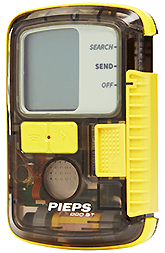


The three basic avalanche tools a ski tourist should always carry are a transceiver (also referred to as a beacon), a shovel, and a probe. Until you are able to buy, borrow, or rent these, it is probable that no experienced backcountry skier will take you seriously, much less go touring with you. Without each of these items, you are not only endangering your life, but the lives of all those in your group - remember, they're counting on you to find and dig them out in case of a burial.
The transceiver is the largest financial commitment; most popular units sell for around $300-$500 and rarely go on sale. They can both transmit and receive a signal from another transceiver (457kHz is the current and only valid frequency for human avalanche rescue; some older units utilize 2.275kHz or use both frequencies). Transceivers should be turned on and worn on the body, preferably under a layer of clothing, while traveling in avalanche terrain and each member of a party should be checked for a working signal before heading out each day. It's a good idea to always carry a spare set of batteries for your unit in your pack (it's also nice to standardize the other electronic gadgets you carry, such as your GPS and headlamp, to fit one size of batteries). Certain electronic devices, especially music players and cell phones, have been shown to sometimes disrupt the functionality of avalanche transceivers, but the effect is very model specific, and often only momentary (especially when turning on another gadget). To be safe, it is recommended that you leave other electronic devices off while using transceivers.
When using an avalanche transceiver as a rescuer, don't be surprised if your unit doesn't lead you to the victim in a straight line. The signal emitted by a sending transceiver is in the shape of a parabola, so depending on the orientation of the sending unit and your unit's ability to translate the received signal, the indicated path to the victim will commonly be curved rather than straight.
Transceivers can be classified as either analog or digital, and some offer both search functions. Purely analog transceivers are still in use, but digital designs offer advantages in speed, accuracy and easy of learning - it's strongly advised that you purchase a newer model rather than trying to buy an older beacon on the cheap. Transceivers can also be differentiated by the number of antennae they have, with all current designs having 3. More antennae, in combination with improved processor capability, enable the transceiver to choose the best (strongest) signal to receive or best antenna to send from - if you're buying a transceiver now, there is no reason to settle for less than 3.
![]()


Digital transceivers utilize a microprocessor to translate the victim's transmitted signal into visual data. They display a directional signal of some sort as well as distance to the victim in meters or feet (analog beacons get louder as you approach the victim, you turn down the volume as you get closer and start a fine search when you have the volume all the way down). For most users, including many experienced ones, digital units are simpler and more intuitive, resulting in faster recovery times, but still require regular practice to be effective.
Multiple antennae and processor technology improves steadily and constantly, and it's hard to keep track of what is current among the various brands and models. Avalanche professionals and testers are also continually discovering model-specific anomalies that you may want to be aware of. If you have a digital transceiver, be aware that firmware for most makes/models is being constantly updated, and check periodically to see if yours is current. For information and ratings on many of the popular full-featured transceivers, see beaconreviews.com.
Regardless of which transceiver you end up with, be sure to practice with it regularly and in realistic surroundings (meaning in snow, not just in your backyard). You and your ski partners should make a point of taking turns burying a backpack or glove with a transceiver set to "send" inside and letting a "rescuer" find and uncover it. When your partner is buried by an avalanche and time is precious, there is no such thing as having had too much practice. Many ski resorts in avalanche-prone regions have practice areas (often referred to as Beacon Basins) that feature permanently buried targets that emit 457khz signals when a search scenario is started by the user. You choose "single" or "multiple" and degree of difficulty, push the start button, and use your own transceiver to locate the "victims." The clock stops and the system sounds when you hit a target with your probe. Highly recommended, both for you and your partners. Hint: Don't dig up the targets!
The second essential item is a shovel. You will need a strong collapsible shovel (metal blades strongly preferred) to dig out a victim, perform snow stability tests, and dig tent platforms or snow caves, not to mention building kickers. Weight is only one factor to consider; blade size and strength are equally important considerations. Grips come in "T", "L" and "D" configurations and each has its proponents; most quality shovels come with an extendable handle as well.
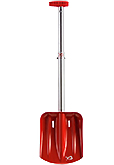
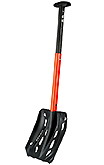
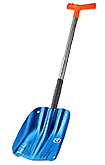
For conducting a fine search, searching for victims in deep avalanche debris, and some snow stability or crevasse work, you will also need an avalanche probe. These are aluminum or carbon fiber sectional poles that assemble in seconds and are held together with a length of cable. There are also probe poles that screw together from two ski pole shafts which some people carry instead of a probe, but these take somewhat longer to assemble (you must remove the baskets, take apart the poles, and screw them together) and are limited to a length of around 6 ft. A good dedicated probe is normally around 240-300cm in length, or in the neighborhood of 8 to 10 feet.
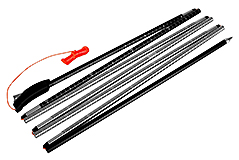
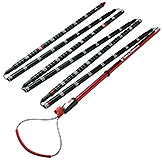
With each of these tools, there is no substitute for regular practice. Being able to deploy each of these items quickly and use them effectively in an emergency is critical in an avalanche burial scenario. It is your life and those of your friends that depend on your mastery of these skills.
I don't consider myself an avalanche expert, and much of the firsthand knowledge I've garnered over the years has been obtained with a measure of luck. I strongly urge those without experience in avalanche prediction, avoidance and rescue to take a class or classes in the subject, and practice what they learn there. Many different options in avalanche education are available through local organizations and private guiding services. Carrying the proper tools does not necessarily make you less vulnerable to death or suffocation by snow burial.
© 2022 Gregory C. Louie